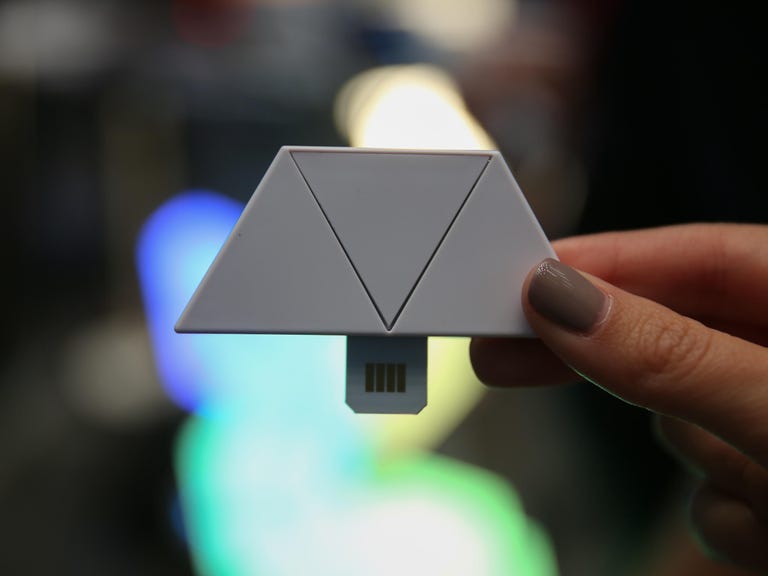 Why You Can Trust CNET
Why You Can Trust CNET Nanoleaf Aurora LED Light Panels (Rhythm Edition) review: Nanoleaf Rhythm will get your Aurora light panels dancing
For 50 bucks, this nifty gadget will sync your Nanoleaf Aurora light panels with whatever music you're listening to.
Nanoleaf's triangular, color-changing Aurora light panels charmed us last year when we tested them in the CNET Smart Home. This year, Nanoleaf released an upgrade for those panels -- the Nanoleaf Rhythm music sync module. Plug it into your panels, and you'll be able to use its built-in microphone to sync colorful lighting changes to the beat of whatever music you're listening to. The cost: $50 on its own, or $230 if you buy it bundled with a nine-panel Aurora starter kit.
The Good
The Bad
The Bottom Line
Rhythm presets range from subtle to striking, and most did a good job of syncing up with a variety of different kinds of music.
Installing the Rhythm module is about as easy as it gets. Just plug it directly into any of the open connector slots on the sides of your Aurora panels, then wait a few seconds. After that, you'll be able to pick from a variety of rhythm-based presets in Nanoleaf's app for Android and iOS devices, and you'll also be able to trigger those presets using voice commands with Alexa , Siri or the Google Assistant.
Like the panels themselves, the Nanoleaf Rhythm is niche novelty for the smart home that isn't for everybody. But if you've already found a place in your home for those Aurora panels (or if you'd like to), then the Rhythm module will give them some undeniably nifty new tricks. That makes it a no-brainer upgrade for anyone who's already invested in Aurora, and a reasonable justification for tech-minded music lovers to consider buying in.
The Rhythm module uses its built-in mic to listen for ambient noise (there's also a 3.5mm aux-in jack on the side if you want to pipe in audio directly). From there, Nanoleaf's software will translate everything the module hears into lighting changes based on the specific preset you've chosen. In my tests, it worked best when the music was coming from a nearby speaker, but it'll work if the music's coming from across the room, too, provided you've got it turned up loud enough.
Some presets will yield bursts of color with every beat, while others will make your display into a makeshift level meter that pulses in rhythm with whatever's playing. Some presets are subtle, some are ostentatious. All of them seemed snappy and responsive in my tests.
If you're creating a preset of your own, you get to choose the animation style and the palette of colors you'd like it to draw from. Playing around with your options and finding the right match for a favorite song is half of the fun.
At the smart apartment now doing some more tests with Nanoleaf Aurora’s music sync module. Rocking out to @ThePassTheBand using the “Streaking Notes” preset. pic.twitter.com/uoGapMtCY4
— Ry Crist (@rycrist) December 8, 2017
I do wish that the preset creator went a little further, though. It would be nice, for instance, if you could tie specific colors and effects to specific panels, or designate different colors and effects for bass and treble. Right now, you can't, but I'll be curious to see if any of that changes in the coming year.
The Rhythm module's center triangle doubles as a physical button that lets you quickly switch between presets without taking your phone out of your pocket or relying on voice commands. That's a welcome design touch, especially since voice commands probably aren't the best option when you've got your music cranked up to 11.
At any rate, Nanoleaf Rhythm leans into the same novelty appeal as the Aurora panels it plugs into, so I have to imagine that most Aurora fans will at least find it intriguing. Fifty dollars seems a bit steep as far as single-feature upgrades are concerned, but it isn't outrageous. Most importantly, the Rhythm module works well, is incredibly easy to use and should improve with time. To me, that's the sort of splurge worth spending on.


